2014 TOYOTA VERSO S clutch
[x] Cancel search: clutchPage 241 of 560
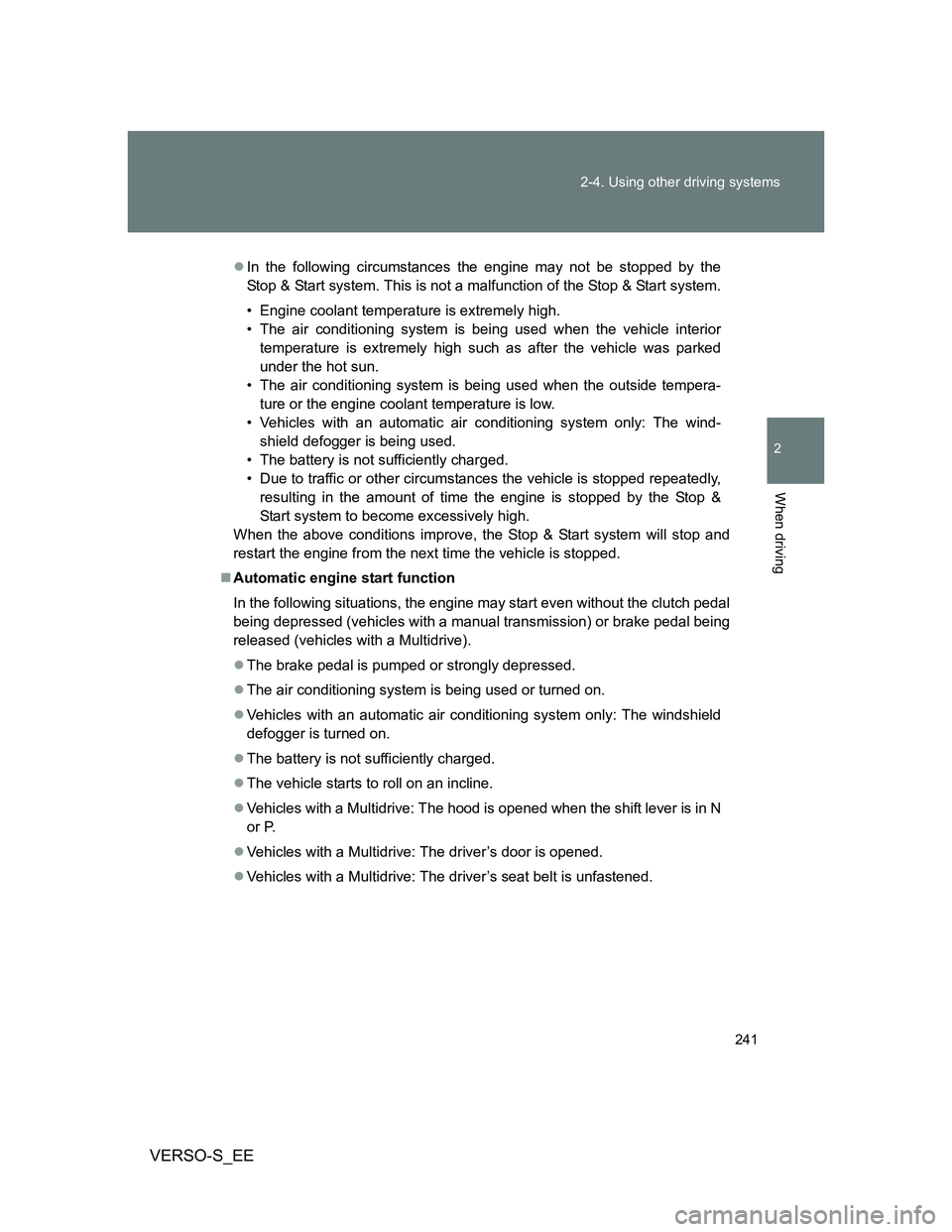
241 2-4. Using other driving systems
2
When driving
VERSO-S_EE
In the following circumstances the engine may not be stopped by the
Stop & Start system. This is not a malfunction of the Stop & Start system.
• Engine coolant temperature is extremely high.
• The air conditioning system is being used when the vehicle interior
temperature is extremely high such as after the vehicle was parked
under the hot sun.
• The air conditioning system is being used when the outside tempera-
ture or the engine coolant temperature is low.
• Vehicles with an automatic air conditioning system only: The wind-
shield defogger is being used.
• The battery is not sufficiently charged.
• Due to traffic or other circumstances the vehicle is stopped repeatedly,
resulting in the amount of time the engine is stopped by the Stop &
Start system to become excessively high.
When the above conditions improve, the Stop & Start system will stop and
restart the engine from the next time the vehicle is stopped.
Automatic engine start function
In the following situations, the engine may start even without the clutch pedal
being depressed (vehicles with a manual transmission) or brake pedal being
released (vehicles with a Multidrive).
The brake pedal is pumped or strongly depressed.
The air conditioning system is being used or turned on.
Vehicles with an automatic air conditioning system only: The windshield
defogger is turned on.
The battery is not sufficiently charged.
The vehicle starts to roll on an incline.
Vehicles with a Multidrive: The hood is opened when the shift lever is in N
or P.
Vehicles with a Multidrive: The driver’s door is opened.
Vehicles with a Multidrive: The driver’s seat belt is unfastened.
Page 243 of 560
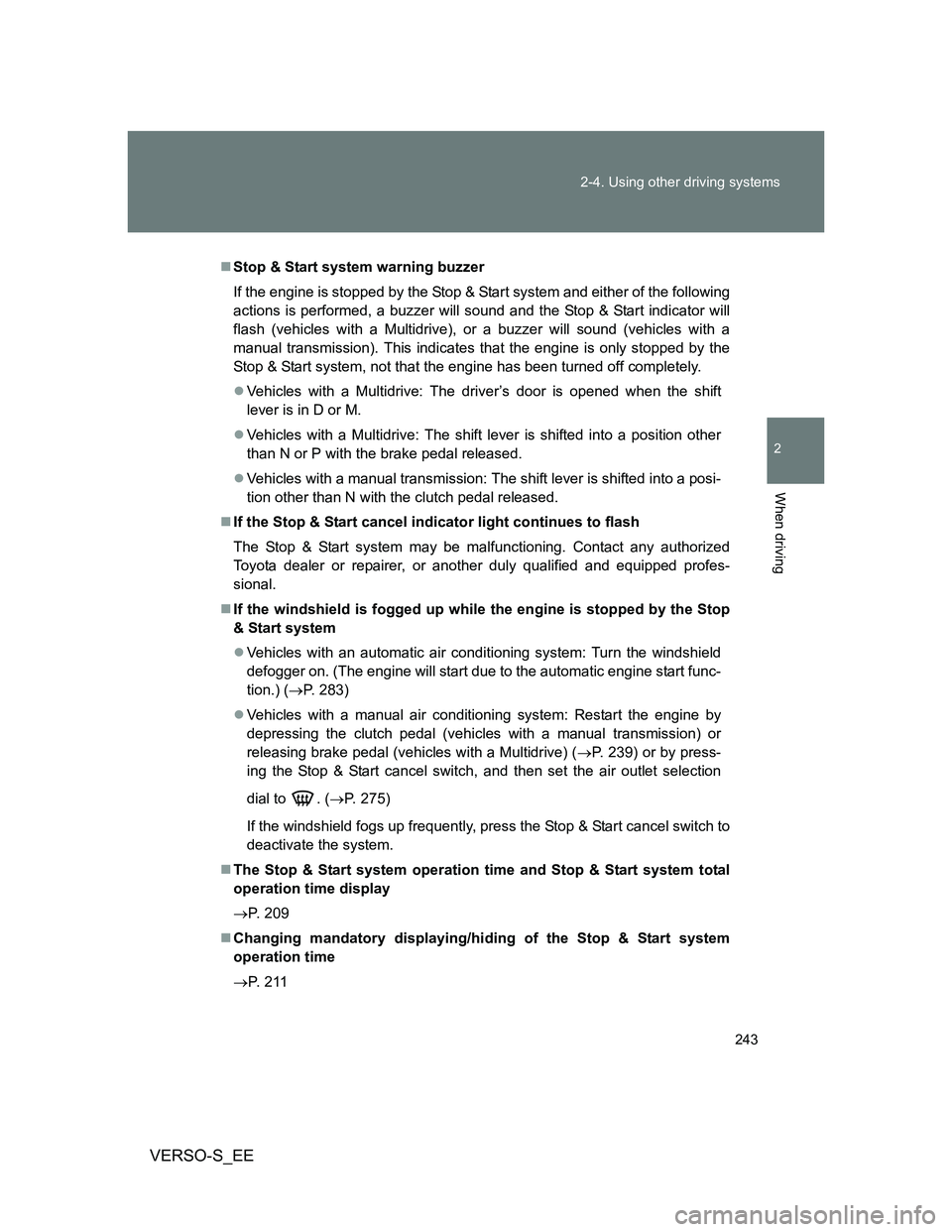
243 2-4. Using other driving systems
2
When driving
VERSO-S_EE
Stop & Start system warning buzzer
If the engine is stopped by the Stop & Start system and either of the following
actions is performed, a buzzer will sound and the Stop & Start indicator will
flash (vehicles with a Multidrive), or a buzzer will sound (vehicles with a
manual transmission). This indicates that the engine is only stopped by the
Stop & Start system, not that the engine has been turned off completely.
Vehicles with a Multidrive: The driver’s door is opened when the shift
lever is in D or M.
Vehicles with a Multidrive: The shift lever is shifted into a position other
than N or P with the brake pedal released.
Vehicles with a manual transmission: The shift lever is shifted into a posi-
tion other than N with the clutch pedal released.
If the Stop & Start cancel indicator light continues to flash
The Stop & Start system may be malfunctioning. Contact any authorized
Toyota dealer or repairer, or another duly qualified and equipped profes-
sional.
If the windshield is fogged up while the engine is stopped by the Stop
& Start system
Vehicles with an automatic air conditioning system: Turn the windshield
defogger on. (The engine will start due to the automatic engine start func-
tion.) (P. 283)
Vehicles with a manual air conditioning system: Restart the engine by
depressing the clutch pedal (vehicles with a manual transmission) or
releasing brake pedal (vehicles with a Multidrive) (P. 239) or by press-
ing the Stop & Start cancel switch, and then set the air outlet selection
dial to . (P. 275)
If the windshield fogs up frequently, press the Stop & Start cancel switch to
deactivate the system.
The Stop & Start system operation time and Stop & Start system total
operation time display
P. 209
Changing mandatory displaying/hiding of the Stop & Start system
operation time
P. 2 1 1
Page 246 of 560
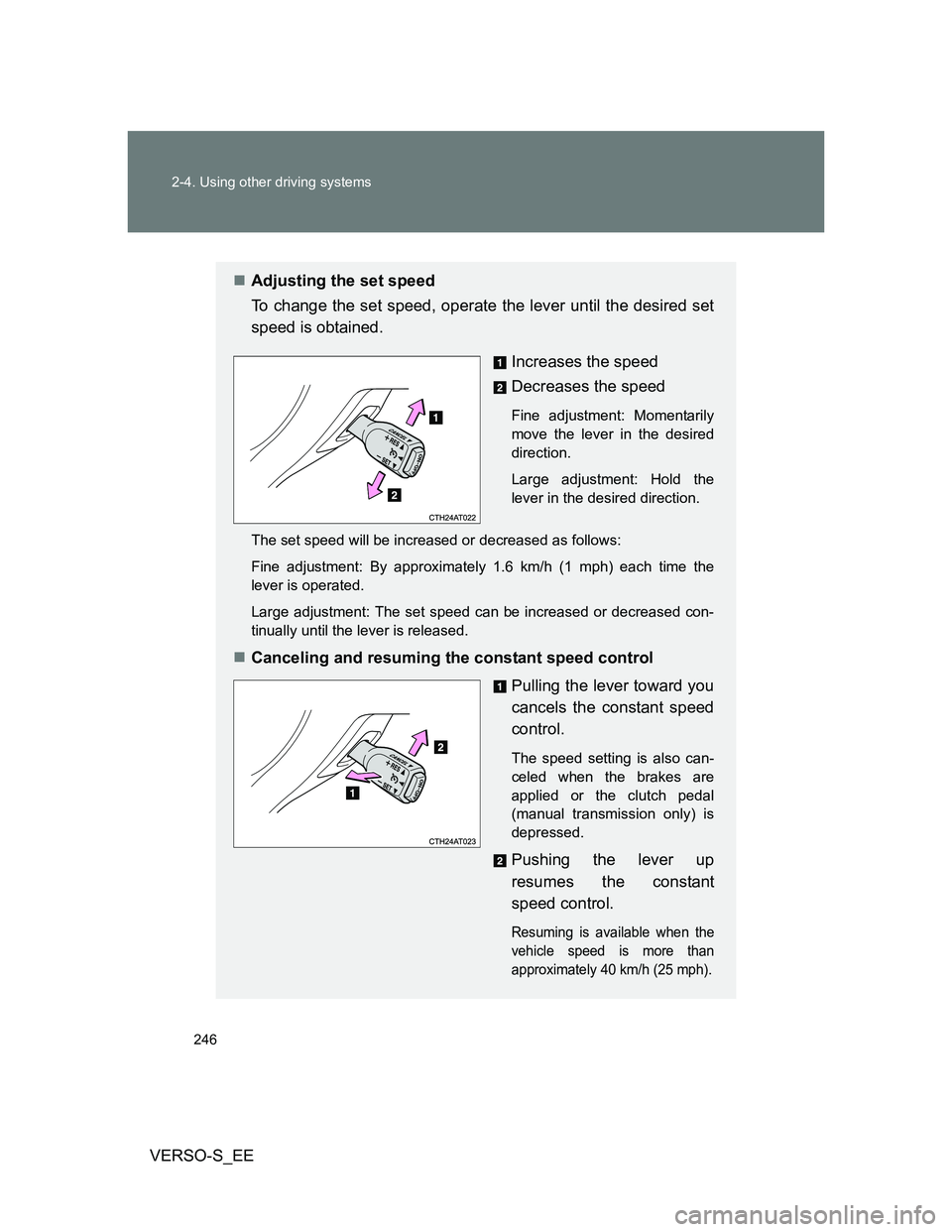
246 2-4. Using other driving systems
VERSO-S_EE
Adjusting the set speed
To change the set speed, operate the lever until the desired set
speed is obtained.
Increases the speed
Decreases the speed
Fine adjustment: Momentarily
move the lever in the desired
direction.
Large adjustment: Hold the
lever in the desired direction.
The set speed will be increased or decreased as follows:
Fine adjustment: By approximately 1.6 km/h (1 mph) each time the
lever is operated.
Large adjustment: The set speed can be increased or decreased con-
tinually until the lever is released.
Canceling and resuming the constant speed control
Pulling the lever toward you
cancels the constant speed
control.
The speed setting is also can-
celed when the brakes are
applied or the clutch pedal
(manual transmission only) is
depressed.
Pushing the lever up
resumes the constant
speed control.
Resuming is available when the
vehicle speed is more than
approximately 40 km/h (25 mph).
Page 257 of 560

257
2
When driving
VERSO-S_EE
2-5. Driving information
Cargo and luggage
CAUTION
Things that must not be carried in the luggage compartment
The following things may cause a fire if loaded in the luggage compartment:
Receptacles containing gasoline
Aerosol cans
Storage precautions
Observe the following precautions.
Failure to do so may result in death or serious injury.
Stow cargo and luggage in the luggage compartment whenever possible.
Do not stack anything in the luggage compartment higher than the seat-
backs.
Such items may be thrown about and possibly injure people in the vehicle
in the event of sudden braking or in an accident.
Do not place cargo or luggage in or on the following locations as the item
may get under the clutch, brake or accelerator pedal and prevent the ped-
als from being depressed properly, block the driver’s vision, or hit the
driver or passengers, causing an accident:
• At the feet of the driver
• On the front passenger or rear seats (when stacking items)
• On the luggage cover
• On the instrument panel
• On the dashboard
Take notice of the following information about storage precautions,
cargo capacity and load:
Stow cargo and luggage in the luggage compartment whenever
possible.
Be sure all items are secured in place.
To maintain vehicle balance while driving, position luggage
evenly within the luggage compartment.
For better fuel economy, do not carry unnecessary weight.
Page 370 of 560
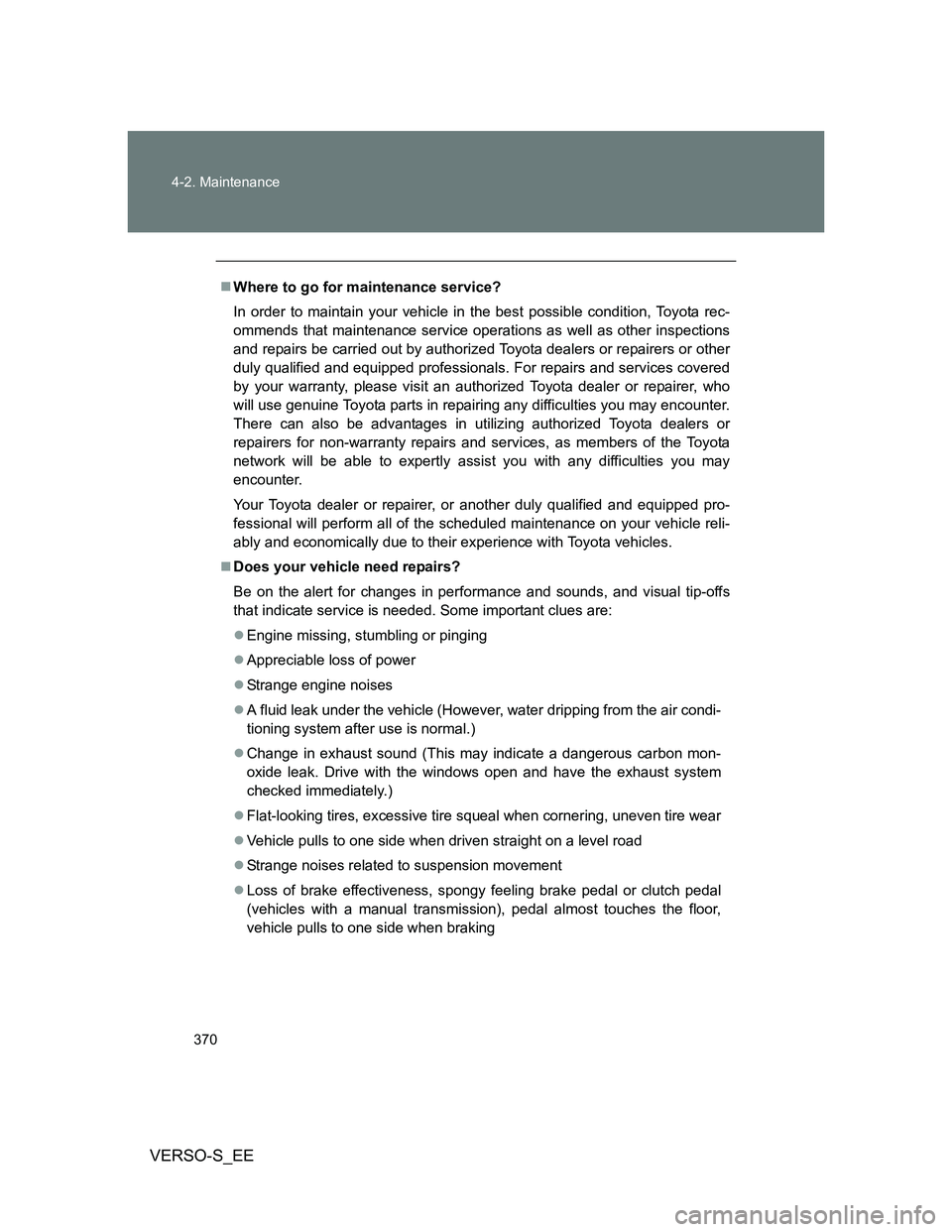
370 4-2. Maintenance
VERSO-S_EE
Where to go for maintenance service?
In order to maintain your vehicle in the best possible condition, Toyota rec-
ommends that maintenance service operations as well as other inspections
and repairs be carried out by authorized Toyota dealers or repairers or other
duly qualified and equipped professionals. For repairs and services covered
by your warranty, please visit an authorized Toyota dealer or repairer, who
will use genuine Toyota parts in repairing any difficulties you may encounter.
There can also be advantages in utilizing authorized Toyota dealers or
repairers for non-warranty repairs and services, as members of the Toyota
network will be able to expertly assist you with any difficulties you may
encounter.
Your Toyota dealer or repairer, or another duly qualified and equipped pro-
fessional will perform all of the scheduled maintenance on your vehicle reli-
ably and economically due to their experience with Toyota vehicles.
Does your vehicle need repairs?
Be on the alert for changes in performance and sounds, and visual tip-offs
that indicate service is needed. Some important clues are:
Engine missing, stumbling or pinging
Appreciable loss of power
Strange engine noises
A fluid leak under the vehicle (However, water dripping from the air condi-
tioning system after use is normal.)
Change in exhaust sound (This may indicate a dangerous carbon mon-
oxide leak. Drive with the windows open and have the exhaust system
checked immediately.)
Flat-looking tires, excessive tire squeal when cornering, uneven tire wear
Vehicle pulls to one side when driven straight on a level road
Strange noises related to suspension movement
Loss of brake effectiveness, spongy feeling brake pedal or clutch pedal
(vehicles with a manual transmission), pedal almost touches the floor,
vehicle pulls to one side when braking
Page 444 of 560
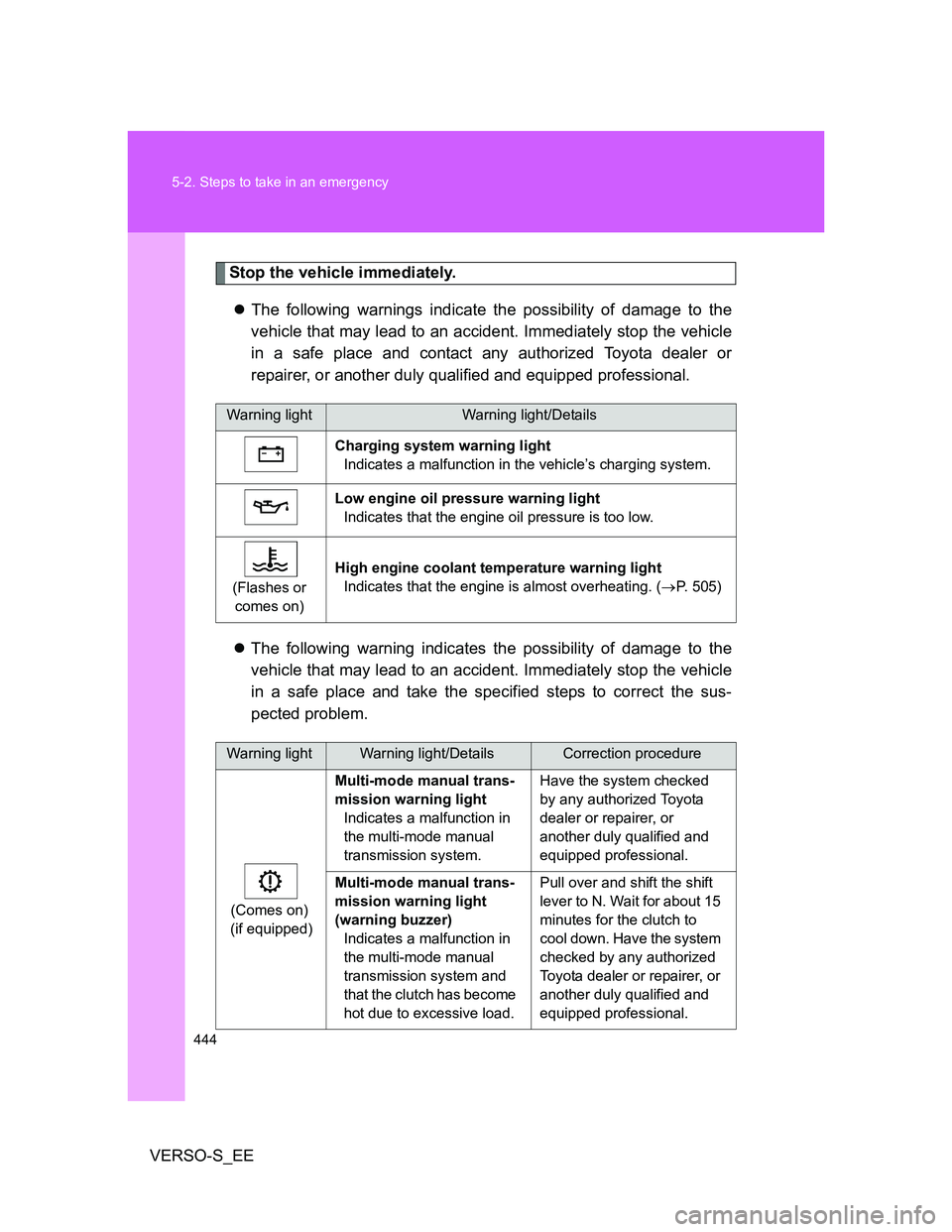
444 5-2. Steps to take in an emergency
VERSO-S_EE
Stop the vehicle immediately.
The following warnings indicate the possibility of damage to the
vehicle that may lead to an accident. Immediately stop the vehicle
in a safe place and contact any authorized Toyota dealer or
repairer, or another duly qualified and equipped professional.
The following warning indicates the possibility of damage to the
vehicle that may lead to an accident. Immediately stop the vehicle
in a safe place and take the specified steps to correct the sus-
pected problem.
Warning lightWarning light/Details
Charging system warning light
Indicates a malfunction in the vehicle’s charging system.
Low engine oil pressure warning light
Indicates that the engine oil pressure is too low.
(Flashes or
comes on)High engine coolant temperature warning light
Indicates that the engine is almost overheating. (P. 505)
Warning lightWarning light/DetailsCorrection procedure
(Comes on)
(if equipped)Multi-mode manual trans-
mission warning light
Indicates a malfunction in
the multi-mode manual
transmission system. Have the system checked
by any authorized Toyota
dealer or repairer, or
another duly qualified and
equipped professional.
Multi-mode manual trans-
mission warning light
(warning buzzer)
Indicates a malfunction in
the multi-mode manual
transmission system and
that the clutch has become
hot due to excessive load. Pull over and shift the shift
lever to N. Wait for about 15
minutes for the clutch to
cool down. Have the system
checked by any authorized
Toyota dealer or repairer, or
another duly qualified and
equipped professional.
Page 445 of 560
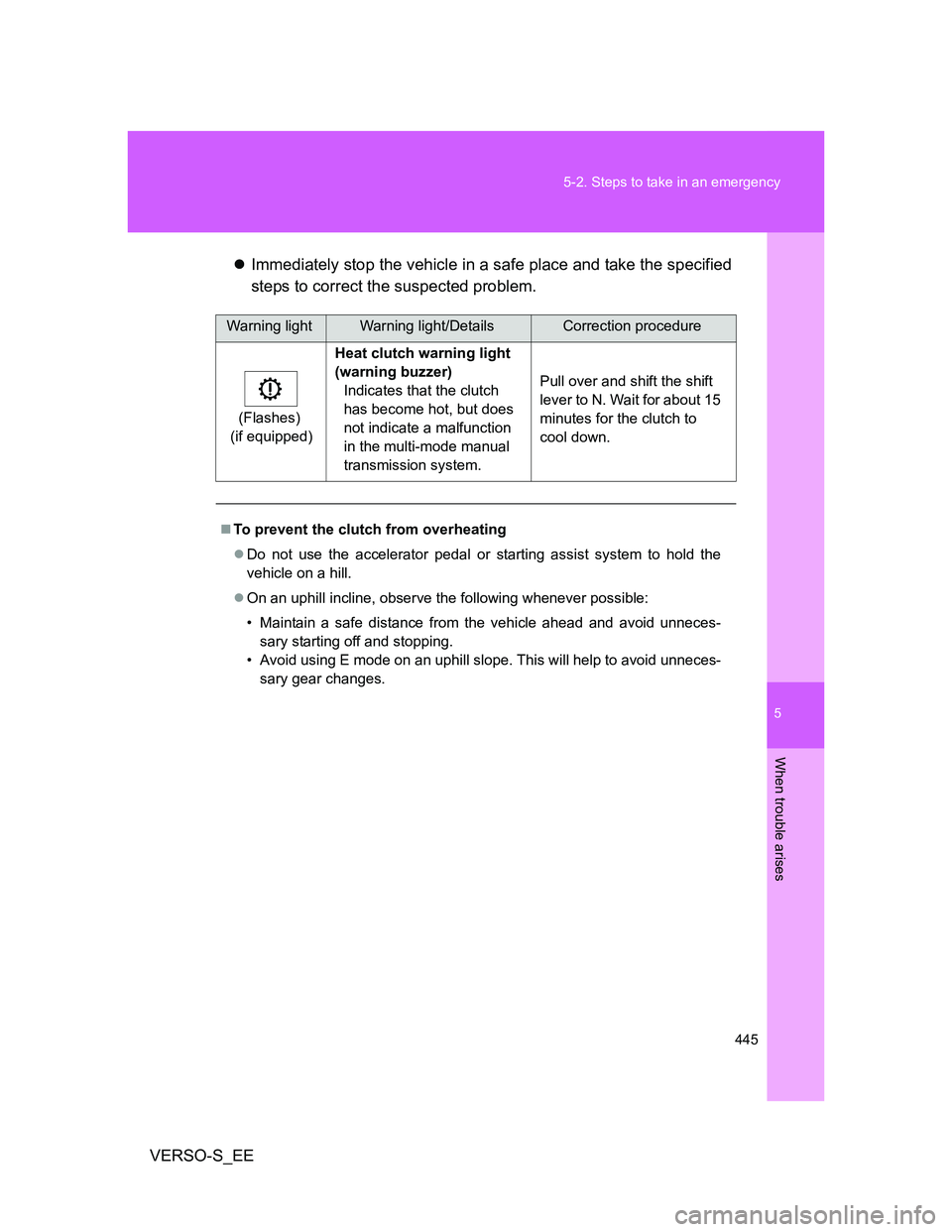
5
445 5-2. Steps to take in an emergency
When trouble arises
VERSO-S_EEImmediately stop the vehicle in a safe place and take the specified
steps to correct the suspected problem.
Warning lightWarning light/DetailsCorrection procedure
(Flashes)
(if equipped)Heat clutch warning light
(warning buzzer)
Indicates that the clutch
has become hot, but does
not indicate a malfunction
in the multi-mode manual
transmission system.Pull over and shift the shift
lever to N. Wait for about 15
minutes for the clutch to
cool down.
To prevent the clutch from overheating
Do not use the accelerator pedal or starting assist system to hold the
vehicle on a hill.
On an uphill incline, observe the following whenever possible:
• Maintain a safe distance from the vehicle ahead and avoid unneces-
sary starting off and stopping.
• Avoid using E mode on an uphill slope. This will help to avoid unneces-
sary gear changes.
Page 453 of 560
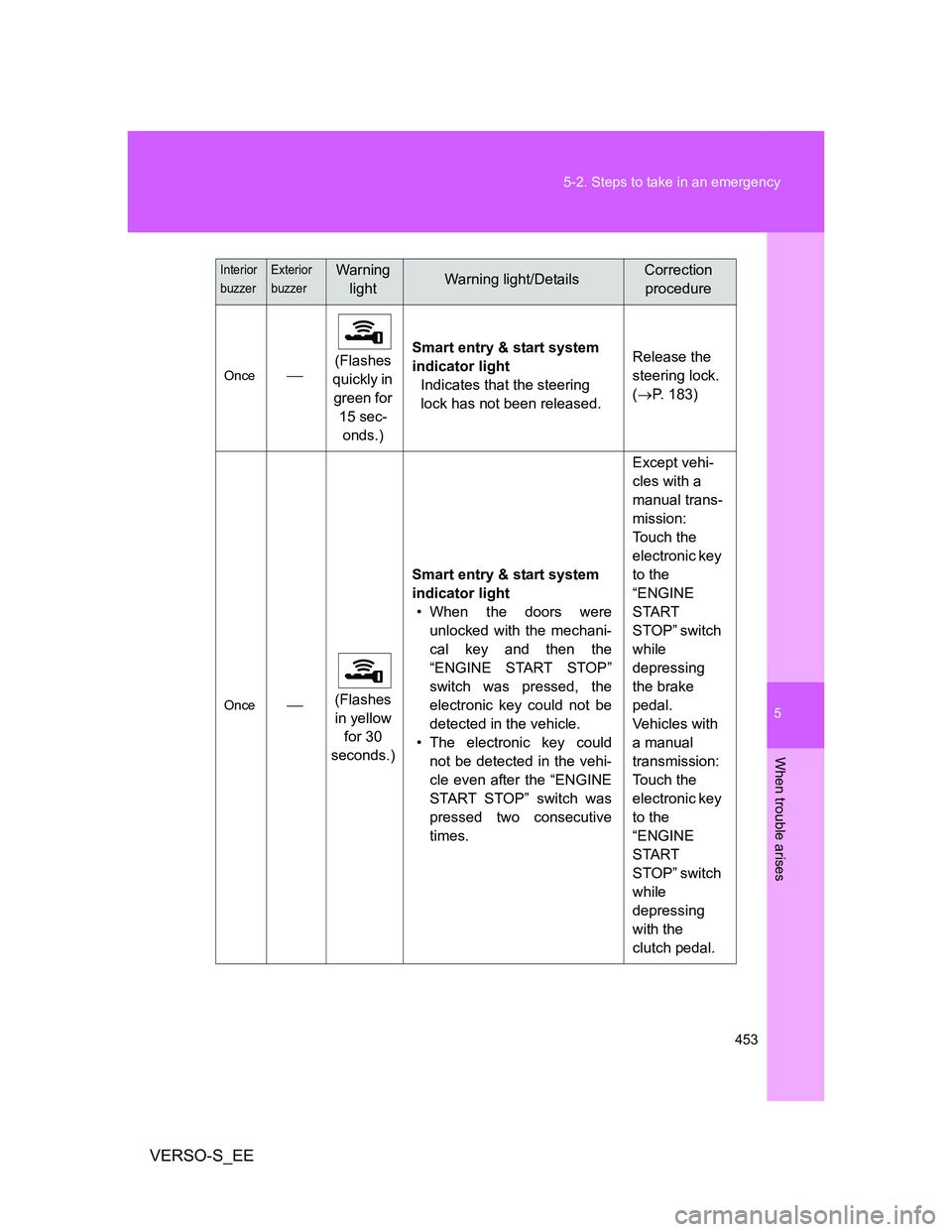
5
453 5-2. Steps to take in an emergency
When trouble arises
VERSO-S_EE
Once(Flashes
quickly in
green for
15 sec-
onds.)Smart entry & start system
indicator light
Indicates that the steering
lock has not been released.Release the
steering lock.
(P. 183)
Once(Flashes
in yellow
for 30
seconds.)Smart entry & start system
indicator light
• When the doors were
unlocked with the mechani-
cal key and then the
“ENGINE START STOP”
switch was pressed, the
electronic key could not be
detected in the vehicle.
• The electronic key could
not be detected in the vehi-
cle even after the “ENGINE
START STOP” switch was
pressed two consecutive
times.Except vehi-
cles with a
manual trans-
mission:
Touch the
electronic key
to the
“ENGINE
START
STOP” switch
while
depressing
the brake
pedal.
Vehicles with
a manual
transmission:
Touch the
electronic key
to the
“ENGINE
START
STOP” switch
while
depressing
with the
clutch pedal.
Interior
buzzerExterior
buzzerWarning
lightWarning light/DetailsCorrection
procedure